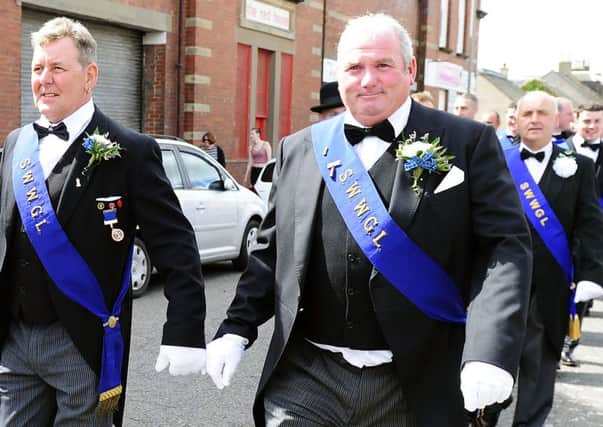Miners march to celebrate their status as free men


Crowds lined the ten mile route from the Reddingmuirhead Institute through Laurieston, Westquarter, Redding and Brightons as nearly 100 took part in the annual ‘Pinkie Walk’.
The event marks colliers’ rights as free men and they dress in formal wear and link pinkies to symbolise their unity.
Advertisement
Hide AdAdvertisement
Hide AdThe Lodge at Reddingmuirhead, which takes its name from one of Scotland’s greatest freedom fighters, is the first and last one of its kind which continues the time-honoured tradition of marching through mining communities to mark the right won by their forefathers around 218 years ago to be treated as equals.
Up until nearly the end of the 18th century miners were treated no better than slaves and could be bound, alongwith their children, to pit owners for their entire lives.
After winning their freedom, miners in Redding and surrounding villages have taken to the streets on the first Saturday of August every year to march together from colliery to colliery to proudly celebrate their hard fought independence from their employers.
Grand Master Willie Allardyce welcomed former miner and ex-MP Sir David Hamilton from Dalkeith as principal speaker on Saturday. Other dignitaries included Falkirk Provost Pat Reid and Upper Braes Councillor Gordon Hughes and the Free Colliers were joined by members of the Linlithgow Reed Band and Bo’ness and Carriden and Broxburn and Livingston Brass Bands.
Advertisement
Hide AdAdvertisement
Hide AdMr Allardyce said: “It was another very successful day. Communities look forward to supporting this important event every year.”
For the last 93 years the march has also commemorated the Redding Pit tragedy, one of the most devastating disasters in the history of Scotland’s coal mining industry.
At just after 4.30am on Tuesday, September 25, 1923, tonnes of freezing water from abandoned workings cascaded into No 23 pit trapping 66 men deep below ground and sparking a major rescue operation.
Within hours, 21 miners had escaped the horror and reached the surface via an old shaft known as the ‘Gutter Hole’, and on October 4 another five emerged - but they were the last.
Advertisement
Hide AdAdvertisement
Hide AdTragically 40 of their workmates never made it, the final bodies recovered early in December as families grieved and stunned communities across Falkirk district shared their pain.
Provost Muirhead and Falkirk Herald owner Fred Johnston organised a disaster fund and it raised over £60,000 - well over £1 million today - within a year.
An official inquiry in February 1924 concluded the main shaft of Redding No 23 flooded after a dyke of hard rock which separated the Dublin Section from the old workings failed.
It found colliery managers employed by the pit operators the Nimmo family of Westquarter did not have positive proof of the thickness of the dyke at that location and should not have allowed coal to be taken from there.
Advertisement
Hide AdAdvertisement
Hide AdRedding No 23 was finally closed in 1958 and in 1980 a memorial stone was unveiled near Redding Cross bearing the names of the dead. On Saturday Grand Chaplain Tom Leadbetter laid a Saltire wreath there in tribute.